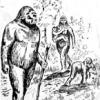From what I am seeing, dumping in lots of data and then sifting through it, there is a pattern somewhat like slash-and-burn farmers. There will be one area with a concentration of encounters, then a break, then a new area, fairly distant from the first one, where a new concentration of encounters occurs. Buy the first chapter of the thesis over in the Northeast Encounters section - nevermind, you get to download it for free there.
There's also some encounters that are consistent w/a wandering male.
I have to say that it's pretty darn enjoyable when you're sorting through data and you randomly check on one or two attributes (e.g., 7' tall, red-haired Bigfoot) and then you find out that a group of these, from different counties, occurred over a 300 square mile area and a 10 or 15-year time span.
But you've really got to slog through the data input and be prepared for a lot of disappointment.

